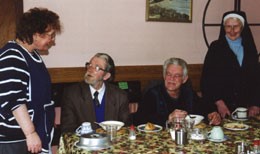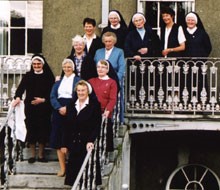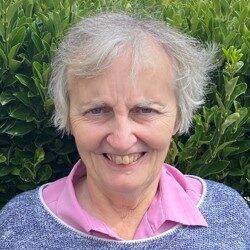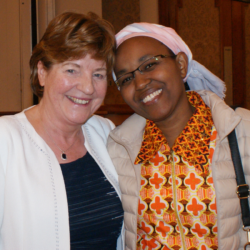Present Day Ministries

In response to a need in the Cork City Region, the Mercy Sisters, enabled Sister Celestine Forrest to set up ‘The Welcome English Language Centre’ to teach English to asylum seekers. For more information please click here.
Charleville, Co Cork
In pre-famine times, Charleville, like so many towns in Ireland had a very large population, but there was great poverty among the people. Some of the more prosperous wished to improve the situation and among them was Mary Clancy. The parish priest, Fr. Thomas Clarke, supported her. One of the ways of improving life in the area was to bring a religious order to the town. The Bishop of the Diocese of Cloyne, Dr. Crotty, made a formal request of Catherine McAuley to send some of her Sisters. She agreed to establish a foundation in Charleville.
On 29th October, 1836 Catherine McAuley arrived in Charleville with Srs. Angela Dunne, Joseph Delaney and Elizabeth Hynes. Mary Clancy provided a house for them on Clancy Terrace and an initial contribution of £500. The house proved very damp and Angela Dunne, fearing for the health of the Sisters, asked Catherine McAuley to close the foundation. However one day while the Sisters visited the very poor in the lane ways a woman stood at her door and said that it was “God himself that drove ye in among us”. This convinced Catherine of the need for the Sisters to remain in Charleville.
About a year later, the foundation stone of a new convent was laid and the convent itself was opened in 1839. Catherine McAuley wrote: “Charleville has hitherto been a sick branch, but it will be a strong one yet.”

Magdalen Flynn and her helpers provide meals for a number of men in the town each day. A meals-on-wheels system is also in operation
The Sisters got involved in education, and gave religious instruction in a local national school. They gradually began to teach full-time. The main stress in those days was on teaching what was known as the “three RS” – reading, writing, and arithmetic. Other subjects such as geography, English grammar, lace making, crochet and religious education were also taught. Newer subjects such as hygiene, history and nature study were introduced in the 1850’s, but the earliest reference to the teaching of Irish is not until the 1920’s.
Soon after the Sisters arrived the Fever Hospital in the town was closed and Lord Cork granted it to them, which they used as an Industrial and Infant School. A secondary school began in a room in the convent in 1839. With the purchase of more land thirty years later a new school was built and opened in April 1894.
Visits were made to the sick and the poor in their homes, while others came to the convent for help. In the 1960’s the Sisters did voluntary nursing in the homes. Today Sisters continue to be involved in education, health care and parish work.
Cork City
Catherine McAuley along with five companions – Mary Clare Moore, Josephine Ward, Vincent Deasy, Teresa White and Anastasia McGawley – arrived in Cork City on the steamer “Hercules” on 6th July, 1837. They were escorted to Rutland Street by a Fr. O’Connor, where they were to live and work for the next fifteen years. Once a fashionable quarter, Rutland Street in 1837, had little of its former elegance. The house itself was a gloomy, sombre building, very much in keeping with convents of the time. However, the Sisters began immediately to visit the poor of the parish and soon they became known as the “sick poor order”. They also began a Pension School in a large room in the house in 1838.
As the number of women joining the order increased, it became necessary to build a bigger convent. On 2nd December, 1850, Bishop William Delaney laid the foundation stone of the new convent in Fitton Street, now Sharman Crawford Street. Named “St. Maries of the Isle” the building is located close to the site of an ancient Dominican Priory. A generous contribution was made by a Ms. Barbara Gould towards the building and the plans included a House of Mercy, a National School and an Orphanage. Gothic in style, the new convent was described as “one of the most beautiful ornaments of the ancient city of Cork”.
 Mary O’Mahony with some of the kids in the primary school early start programme in Mayfield, Cork City
Mary O’Mahony with some of the kids in the primary school early start programme in Mayfield, Cork City
The Sisters moved to their new home on 2nd October, 1852. The Pension School was named St. Aloysius School, and this in turn became the first secondary school for girls in the city. The earliest extant register for this school is dated 1887. In 1853 an Infant School and an Industrial School were opened. Later with the acquisition of more land, adjacent to the convent, St. Joseph’s National School was built.
Over time branch houses were opened and today Sisters are engaged in a different ministries in the city.
Kinsale
 Some members of the Kinsale community
Some members of the Kinsale community
On 19th April, 1844, the convent in Kinsale was founded from Limerick. The Foundress Mother Mary Ann Burke was accompanied by Mother Francis Bridgeman, (who had worked in the Crimea during the war), Srs. Xavier Daly and Mary Martha. By July of that same year, the foundation stones of schools and part of the convent were laid. On the opening day of the school 700 children enrolled with only 6 Sisters to teach them. Along with catering for their educational needs, the Sisters supplied food to the children twice daily.
The 1840’s were a time of great hardship for most parts of Ireland and Kinsale was not any different. As well as providing education for the children, the Sisters provided food and medical aid for those in the town in greatest need, and they served in the local workhouse. They also provided some employment in the town, establishing net-making and rope making for the fishermen, and lace making and embroidery for the women. The lace making industry in Kinsale later gained world renown.
While the convent has recently closed the Sisters still live in Kinsale and some continue to work in education as well as in pastoral and parish work.
Mallow
On 13th October, 1845, Elizabeth Moore, the Reverend Mother of Limerick Convent of Mercy, along with seven Sisters, set out to establish a foundation in Mallow. The house to which they arrived was cold, dark and wet having been washed down that day in preparation for their arrival. No food or firewood had been provided, based on the notion by the townspeople that “Nuns did not require such earthly commodities!”
The home to which this pioneer group came was a rented house beside the Parish Church. In later years it became the Mallow Branch of the National Bank, now the Mallow Credit Union. From this convent the Sisters began visiting the sick and they also started teaching in the Parish School. The school was situated in the present Chapel Lane and close on seven hundred pupils attended.
During the famine year of 1846 – 1947 the famine fever was particularly severe and the Sisters were kept busy day and night caring for those affected. A young novice Mary Xavier Creagh, who had been a most constant companion in the night watching, fell ill and her symptoms soon indicated it was the dreaded fever. She died on 25th June, 1847 and she is buried in the graveyard beside the churchyard.
In 1848 the purchase of lands and the building of a convent was made possible by the generosity of Miss Gould, whose vast fortune had been vested in Trustees for some religious purpose in the then Diocese of Cloyne and Ross. Miss Gould, herself later joined the Presentation Sisters in Youghal, Co Cork. In 1850 the Sisters moved from Bank Place to Bathview.
In 1851 an orphanage was opened, which cared for orphans and children from broken and emotionally disturbed homes, until its recent closure.
The National school was built about this time also and the tradition of teaching in the building continues up to the present. The secondary school was opened in 1932 with further buildings added during the 1950’s and 1960’s.
The Sisters continue their involvement in Mallow today.


